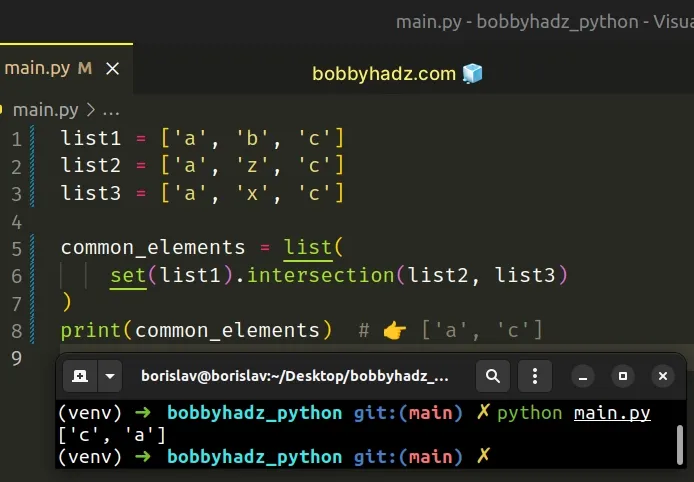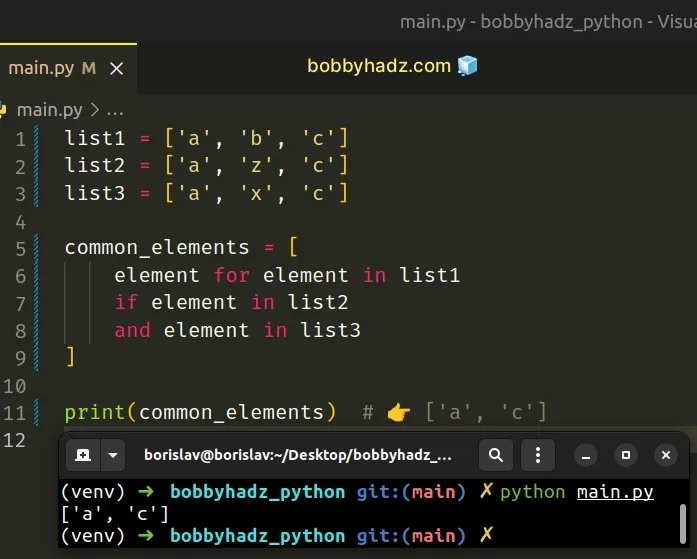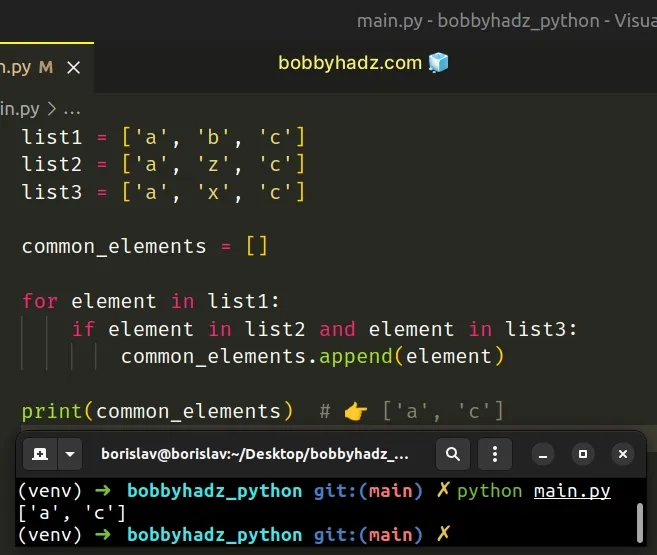Find common values in multiple Lists in Python
Last updated: Apr 10, 2024
Reading time·5 min

# Table of Contents
# Find common values in multiple lists in Python
To find the common values in multiple lists:
- Convert the first list to a
setobject. - Use the
intersection()method on theset. - The
intersectionmethod will return the common elements in the lists.
list1 = ['a', 'b', 'c'] list2 = ['a', 'z', 'c'] list3 = ['a', 'x', 'c'] common_elements = list( set(list1).intersection(list2, list3) ) print(common_elements) # 👉️ ['a', 'c']

If you need to find the common elements in a list of lists, click on the following subheading:
The example finds the common elements in three lists, but you can use this approach with as many lists as necessary.
We used the set() class to convert the first list to a set.
The set() class takes an
iterable optional argument and returns a new set object with elements taken
from the iterable.
list1 = ['a', 'b', 'c'] print(set(list1)) # 👉️ {'a', 'b', 'c'}
intersection() method.The
intersection()
method returns a new set with elements common to the provided objects.
list1 = ['a', 'b', 'c'] list2 = ['a', 'z', 'c'] list3 = ['a', 'x', 'c'] common_elements = list( set(list1).intersection(list2, list3) ) print(common_elements) # 👉️ ['a', 'c'] print(len(common_elements)) # 👉️ 2
len() function if you need to get the number of common elements between the lists.Alternatively, you can use a list comprehension.
# Find common values in multiple lists using a list comprehension
This is a three-step process:
- Use a list comprehension to iterate over the first list.
- Check if each element is present in the other lists and return the result.
- The new list will only contain the common elements between the lists.
list1 = ['a', 'b', 'c'] list2 = ['a', 'z', 'c'] list3 = ['a', 'x', 'c'] common_elements = [ element for element in list1 if element in list2 and element in list3 ] print(common_elements) # 👉️ ['a', 'c']

We used a list comprehension to iterate over the first list.
On each iteration, we check if the current item is present in the two other lists and return the result.
The new list only contains the elements that are present in all three lists.
The in operator tests
for membership. For example, x in l evaluates to True if x is a member of
l, otherwise, it evaluates to False.
Alternatively, you can use a simple for loop.
# Find common values in multiple lists using a for loop
This is a three-step process:
- Use a
forloop to iterate over the first list. - Check if each item is contained in the other lists.
- Append the matching items to a new list.
list1 = ['a', 'b', 'c'] list2 = ['a', 'z', 'c'] list3 = ['a', 'x', 'c'] common_elements = [] for element in list1: if element in list2 and element in list3: common_elements.append(element) print(common_elements) # 👉️ ['a', 'c']

We used a for loop to iterate over the first list.
On each iteration, we use the in operator to check if the current item is
contained in the other two lists.
If the condition is met, we append the value to a new list.
The list.append() method adds an item to the end of the list.
my_list = ['bobby', 'hadz'] my_list.append('com') print(my_list) # 👉️ ['bobby', 'hadz', 'com']
The method returns None as it mutates the original list.
# Find the common elements in a List of Lists in Python
To find the common elements in a list of lists:
- Convert the first element in the list to a
set. - Call the
intersection()method on theset. - The method will return the common elements in the list of lists.
list_of_lists = [ [4, 7, 9], [4, 9, 9], [4, 1, 9] ] common_elements = set( list_of_lists[0] ).intersection(*list_of_lists) print(common_elements) # 👉️ {9, 4} print(list(common_elements)) # 👉️ [9, 4]
We used the set() class to convert the first nested list to a set object.
list_of_lists = [ [4, 7, 9], [4, 9, 9], [4, 1, 9] ] print(set(list_of_lists[0])) # 👉️ {9, 4, 7}
intersection() method.The
intersection()
method returns a new set with elements common to both set objects.
list_of_lists = [ [4, 7, 9], [4, 9, 9], [4, 1, 9] ] common_elements = set( list_of_lists[0] ).intersection(*list_of_lists) print(common_elements) # 👉️ {9, 4} print(list(common_elements)) # 👉️ [9, 4]
We called the intersection() method on the set and used the iterable
unpacking operator to unpack the list of lists in the call to the method.
The * iterable unpacking operator enables us to unpack an iterable in function calls, in comprehensions and in generator expressions.
You can imagine that the nested lists got passed as multiple, comma-separated
arguments to the intersection method.
The intersection method then returned a set object containing the common
elements in the lists.
Use the list() class if you need to convert the set to a list.
The list class takes an iterable and returns a list object.
Alternatively, you can use the intersection_update() method.
# Find the common elements in a List of Lists using intersection_update()
This is a three-step process:
- Convert the first element in the list to a
set. - Use a
forloop to iterate over the rest of the list. - Use the
intersection_updatemethod to find the common elements.
list_of_lists = [ [4, 7, 9], [4, 9, 9], [4, 1, 9] ] common_elements = set(list_of_lists[0]) for l in list_of_lists[1:]: common_elements.intersection_update(l) print(common_elements) # {9, 4}
We converted the first nested list to a set and stored the result in a
variable.
We then used a for loop to iterate over the rest of the list.
list_of_lists[1:] starts at index 1 and goes to the end of the list.On each iteration, we use the intersection_update method to update the set
with the intersection of itself and the list.
The
intersection_update
method updates the set in place.
After the last iteration, the variable stores the common elements in the list of lists.
# Additional Resources
You can learn more about the related topics by checking out the following tutorials:

